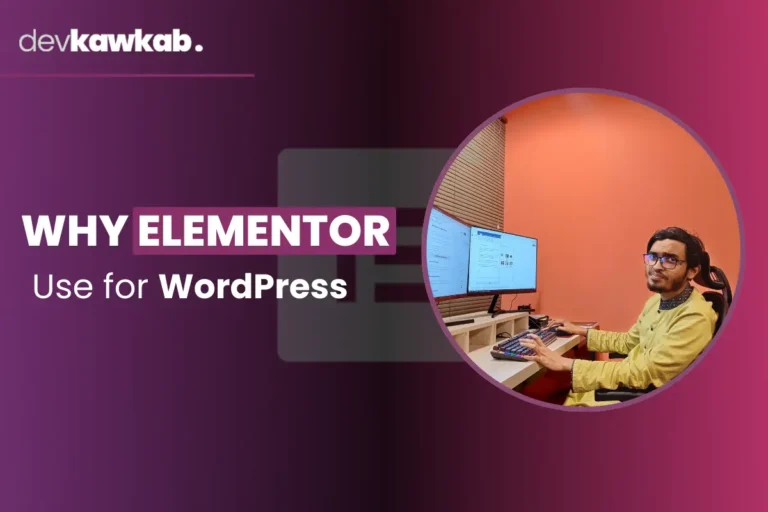Ever been in the middle of creating a stunning page with Elementor, only to hit save and… nothing? It’s like all your hard work just vanished into thin air! Don’t worry, you’re not the only one dealing with this. Many Elementor users face the frustrating issue of changes not being saved, but there’s always a reason behind it – and a fix waiting for you.
The main culprits? They can range from pesky cache problems, conflicting plugins, or even your server settings playing tricks on you. Each of these issues can stop Elementor from saving your beautiful changes, leaving you scratching your head. But the good news? Most of these problems are easy to solve.
In this article, we’ll break down the most common reasons why Elementor isn’t saving changes and guide you through step-by-step solutions. Let’s uncover the fixes so you can get back to designing without a hitch!
Read More – Why Elementor is Not Working?
What Causes Elementor to Stop Saving Changes?
There are a variety of reasons Elementor might stop saving your changes. Some of them are straightforward, like a minor plugin conflict, and others might be more technical, such as server configuration issues. But it all boils down to one thing: Elementor isn’t communicating properly with WordPress.
The good news? These issues are almost always fixable. The not-so-good news? It might take some trial and error. But hey, we’re here to make that process a lot smoother for you!
How Can Cache Issues Affect Elementor’s Ability to Save Changes?
Cache is a wonderful thing. It makes websites load faster by storing copies of web pages. But when you’re working with Elementor, cache can sometimes be the enemy.
If you notice Elementor not saving your changes, it might be because of cached versions of your page being displayed rather than the updated one.
Solution: Clear your browser’s cache, the cache from any caching plugins (like WP Super Cache or W3 Total Cache), and if your host has server-level caching, you’ll want to clear that too.
Is Your Server Configuration Preventing Elementor from Saving Changes?
Sometimes, the problem lies with your hosting provider. There are certain PHP settings that need to be optimized for Elementor to function correctly. If your server configuration doesn’t meet Elementor’s requirements, you may face trouble saving changes.
Here’s a quick checklist to ensure your server configuration is Elementor-friendly:
- PHP version should be 7.4 or higher
- Memory limit of at least 256MB
- Post Max Size of 50MB or more
- Max Execution Time of 300 seconds
- Max Input Vars should be set to 4000 or higher
You can find these settings in your WordPress dashboard under Tools > Site Health > Info.
Could Plugin Conflicts Be the Reason Elementor Isn’t Saving Updates?
WordPress is an ecosystem of plugins, and while that’s great for adding features, it can also lead to conflicts. A plugin conflict might cause Elementor to fail when saving changes.
Some common culprits are caching or optimization plugins that minify or combine scripts. Others might include plugins that modify the visual editor, like page speed boosters or security plugins.
How to Spot the Culprit?
- Deactivate all plugins except Elementor and Elementor Pro.
- Try saving changes in Elementor again.
- If it works, reactivate the plugins one by one until you find the troublemaker.
Once you know which plugin is causing the issue, you can either find an alternative or tweak its settings to play nice with Elementor.
Read More – Why Elementor Use for WordPress?
What Role Does the Elementor Editor Memory Limit Play in Saving Changes?
Ever noticed your Elementor page builder running slow or not saving changes? It could be because of memory issues. Elementor, being a visual editor, requires more memory than your average WordPress page. The default WordPress memory limit might not be enough.
A quick way to check this is to increase the WordPress memory limit. Here’s how you do it:
- Open your wp-config.php file in your WordPress root directory.
- Look for this line: define (‘WP_MEMORY_LIMIT’, ’64M‘);
- Change it to define (‘WP_MEMORY_LIMIT’, ‘256M‘);
With that increased memory, Elementor will have more room to operate and will likely save your changes without a hitch.
How Can Database Issues Stop Elementor from Saving Your Work?
Your WordPress database is like the brain of your site. Every single change, from a new post to a layout adjustment in Elementor, is saved there. If there’s an issue with your database, it can prevent Elementor from saving changes.
Possible causes of database issues include:
- Database tables are corrupted.
- The database is overburdened with data and not optimized.
A quick fix is to use a plugin like WP-Optimize to clean and optimize your database. This will clear out unnecessary data and make sure the database is running smoothly.
Are Browser Extensions or Settings Stopping Elementor from Saving Changes?
Your browser might be secretly sabotaging your Elementor experience! Extensions, like ad blockers or privacy tools, sometimes interfere with how web pages load and save data. For example, an aggressive script blocker might prevent Elementor from saving changes.
How to check:
- Open your Elementor editor in incognito mode (this disables all extensions).
- Try saving changes.
- If it works, one of your extensions is the culprit.
From there, you can disable them one by one to find the guilty extension. Alternatively, use a different browser altogether when editing with Elementor.
Why Does Refreshing Elementor Sometimes Solve the Save Issue?
Sometimes, a simple refresh is all it takes. Elementor, like any other web-based tool, can get a little buggy after prolonged use. If you’ve been working on a page for a while, you may experience lagging or saving issues.
Refreshing the editor essentially reloads everything and might clear up any temporary bugs. Before you hit refresh, be sure to save your draft! You don’t want to lose all your hard work.
How Do Outdated Themes or Plugins Interfere with Saving Changes in Elementor?
It might sound basic, but outdated themes and plugins are a common culprit behind Elementor save issues.
Compatibility is key in WordPress, and if you’re running an older version of a theme or plugin, they may not play nice with the latest version of Elementor.
To prevent this, always make sure:
- Your WordPress version is up to date.
- Themes and plugins are regularly updated.
- Elementor is running on its latest version.
Table: Differences between Common Plugin Conflicts vs. Server Configuration Issues
| Issue | Plugin Conflict | Server Configuration Issue |
|---|---|---|
| Symptom | Elementor changes not saving due to plugin | Changes not saving due to low memory or incorrect PHP settings |
| Causes | Caching, optimization, or script-blocking plugins | Outdated PHP version, low memory limit, insufficient execution time |
| Solution | Deactivate plugins one by one to find the conflict | Update server settings (PHP version, memory, max input vars) |
| Difficulty to fix | Moderate (trial and error with plugins) | May require contacting your hosting provider |
| Frequency | Occasional (depends on installed plugins) | Less frequent but more technical |
Wrapping Up
Elementor is a powerful tool, but like any other technology, it has its quirks. If you find that your changes aren’t being saved, don’t panic!
There’s always a reason – and a fix. Whether it’s a sneaky plugin conflict, a memory limit issue, or just a cache needing to be cleared, following these steps will help you pinpoint and resolve the problem.
By checking for plugin conflicts, adjusting server settings, clearing cache, or updating your extensions, you’ll be back to building beautiful websites in no time. Just remember: when in doubt, refresh your browser and take it step by step.



